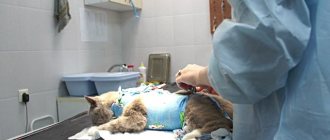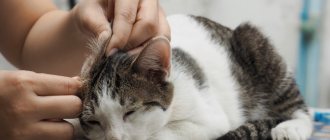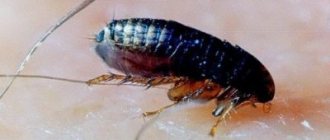6 diseases that can cause a lump in cats: how to treat
Lumps or tumors on the abdomen in cats are symptoms of the following diseases or pathological conditions:
- Mastopathy.
- Hernia.
- Hypertrophy of lymph nodes.
- Paraproctitis is inflammation of the paraanal glands.
- Skin pathologies - abscesses, boils, tumors.
- Lipoma or wen.
Mastopathy
The mammary glands enlarge before lambing because they synthesize colostrum. This is a normal phenomenon, but when the bumps remain after the cessation of lactation or occur during the period of anestrus, that is, a decrease in sexual activity, you need to contact a veterinarian.
Most often, older females get sick for the following reasons:
- frequent absences - heats that do not end in fruitful mating;
- imaginary pregnancies - conditions in which a cat behaves like a mother, but does not produce kittens;
- interruption of lactation: cat owners destroy unwanted offspring;
- frequent use of Sex Barrier type contraceptives;
The pathological process can last for years. First, small nodules and small bumps are formed, of which there can be many. The tumor grows, acquires a bluish-purple color, and fistulas form. In this condition, only symptomatic therapy is effective to alleviate suffering. Surgical removal of the tumor can prolong life by several weeks or months.
Be sure to read:
A cat's hair is falling out: reasons, what to do during shedding, treatment of baldness, approved medications
Prevention consists of regular matings: after lambing, one oestrus is skipped. During the next one happens. You should stop using contraceptives or use them no more than once every six months. Females who have reached the age of six, as well as pets who have been diagnosed with an imaginary pregnancy, are recommended to be neutered.
Hernia
Lumps are organs that have prolapsed under the skin due to a hole in the abdominal wall. There are two reasons: a developmental anomaly or a postoperative complication. The veterinarian clarifies what kind of hernia it is.
If not strangulated, conservative treatment is prescribed. If unsuccessful, a surgical operation is performed. Strangulated hernias are repaired surgically as soon as possible to avoid complications that threaten the pet's life.
Lymph node hypertrophy
The pathological condition is called lymphadenitis. A dense lump is formed as the body’s response to an infectious disease. After eliminating the cause, the lump decreases and ceases to be palpable.
Paraproctitis
In healthy cats that lead an active lifestyle, the anal glands cleanse themselves. However, in obese couch potatoes, secretion stagnates, becomes overfilled, and becomes inflamed. The development of paraproctitis is promoted by eating fried foods and other human delicacies, as well as frequent constipation caused by other reasons.
The veterinarian has to make a choice between a perineal hernia and paraproctitis. If it is an uncastrated male or female, then the glands are inflamed. The veterinarian cleans the anal sacs and teaches a simple technique to the cat owner. If suppuration develops, they operate.
Skin pathologies
The veterinarian determines the type of disease, opens the abscess, and sanitizes the pathological cavity. If a boil or carbuncle occurs, apply external remedies.
If neoplasms occur, a biopsy is performed to confirm or refute the presence of malignant tumors. If fibroma, hemangioma or lymphangioma is diagnosed, the tumor is removed if the prognosis is favorable. When treating sarcoma, tumor removal, chemotherapy and radiation are practiced. The prognosis is doubtful.
Lipoma
Wen is a benign formation that occurs mainly in older animals. If the tumor does not bother the pet and does not increase in size, it is not touched.
Be sure to read:
Sores on a cat’s neck that itch and hair fall out: normal or pathological, reasons, what to do
Prevention of cancer in cats
Unfortunately, it is not possible to prevent cancer using preventive measures. However, there are recommendations that can significantly reduce the risk:
- Spay your pet. A cat whose ovaries and uterus are removed significantly reduces the likelihood of developing cancer.
- Get checked by a veterinarian. A pet whose age has exceeded 8 years is at risk. Timely diagnosis is a chance for successful treatment.
- Watch for formations to appear. Part the fur covering the main access to the skin at each inspection and seek help if in any doubt.
- Stop taking hormonal contraceptives. Suppression of sexual desire is the main factor influencing the development of cancer. If you don’t want a walking cat, use point 1.
- Provide proper care and a balanced diet. Don't let your immunity drop.
In conclusion, I would like to note the importance of medical diagnosis when cancer is suspected. Cancer is a terrible disease that progresses every year. Be vigilant and check your pet even if there are symptoms indicating a benign formation.
Symptoms of a tumor on a cat's stomach
A caring owner has probably already wondered what the symptoms and signs of a tumor are in a cat. These signs are not highly specific and can easily be confused with another disease. The signs can be confused with poisoning or toxicosis (if it is a female) here they are: weakness, loss of appetite, loss of former playfulness, activity, the animal prefers to lie down and rest.
Predisposing factors
Now let's look at the main reasons that may contribute to the development of this pathology. First, right-sided congestive heart failure. Usually the disease in this case is a consequence of hereditary defects of the heart muscle. As the heart becomes less efficient at pumping blood, the pressure in the vessels in the abdominal and chest cavity gradually increases, causing their walls to gradually leak fluid. Secondly, liver cirrhosis. The portal vein is compressed by the compacted tissue, resulting in the formation of effusion.
Preventive actions
There is no specific prevention of mammary cancer in cats. Yes, veterinarians advise early sterilization of animals before puberty or during the first two years of life. Even this cannot give an absolute guarantee that the female will not get sick.
Once the cat reaches a critical age (7-10 years), it is recommended to conduct a clinical examination at least once every six months in a veterinary clinic. And the felinologist himself, stroking his pet’s belly every day, must pay close attention to the suddenly formed tubercles that were not there before.
Other preventive measures worth noting:
- good care and maintenance;
- proper nutrition;
- timely treatment of a cat for mastitis and diseases of the genital organs (endometritis, pyometra, etc.);
- refusal to use hormones that disrupt the sexual cycle.
Unfortunately, doctors cannot accurately define preventive measures regarding oncology. But you can reduce your cat's risk of developing cancer.
Veterinarians recommend the following:
- Sterilize the animal before puberty, or in the first two years of the cat’s life.
- Examine the animal daily for the presence of tumors.
- Conduct a preventive examination at a veterinary clinic at least once every six months. This is especially true for animals at a critical age - 7-10 years.
In addition, doctors recommend abandoning hormonal drugs to block estrus and false pregnancy, promptly treating the cat for diseases of the genital organs and mastitis, feeding the animal properly and caring for it.
Why you can’t give up when fighting a tumor on your cat’s stomach
A tumor in a cat’s stomach is one of the most mysterious diseases, which even today has not been fully studied by doctors, and therefore can disappear as suddenly as it appeared, or give multiple metastases, and then take root throughout the body. Remember that by stopping the fight against a tumor in a cat, you are thereby putting an end to the life of your pet; she can die at any moment due to your laziness and unwillingness to fight to the end. Veterinary doctors are doing everything in their power to save another life and a grateful animal jumped into your lap every day.
Lump under the skin
Sometimes the owner may find lumps (bumps) on the animal’s body. Their origin can be different: from harmless to very serious. Small bumps are called papules, and larger ones are called nodules. This is quite common in adult cats.
Lumps can be benign or malignant. Diagnostics will help find out this, and after the diagnosis is made, treatment will be prescribed.
Very often the word “neoplastic” is associated with a disease such as cancer. But this is not always the case; there are many reasons for the occurrence of tumors.
The lump can be a malignant or benign tumor, an abscess, a cyst, a hematoma, or a skin reaction to an allergen, a fatty tumor (lipoma).
Remember, any seal must be examined to avoid serious consequences.
Symptoms
Any lump on your pet’s body should not be left unattended, and you should especially pay attention to a lump that is growing rapidly, has become hot or painful, is festering or bleeding. If you notice any of the above signs, you should contact your veterinarian.
When your cat has a lump under the skin and you, not knowing what to do, are looking for advice on this topic on the Internet on forums, we recommend not to self-medicate and experiment on your beloved cat. The fact is that there are many reasons for the appearance of seals in an animal, and the consequences of your experiment may disappoint you and your family.
Diagnostics
Your veterinarian will need a complete medical history of your pet to make a correct diagnosis. You may be asked the following questions:
- How long has the lump appeared?
- Has the seal increased in size or changed visually?
- How quickly does the seal grow?
- Has your pet been given injections or had any recent injuries?
- Does the cat have one bump or are there others?
- Are there any changes in your pet's behavior (eating less, weight loss, vomiting, diarrhea, or lethargy)?
Afterwards, the veterinarian will conduct a thorough medical examination and prescribe the following diagnostic tests:
- Cytology. This test usually does not require anesthesia and helps establish the diagnosis.
- Examination of a tumor or fluid from it using a microscope.
- Biopsy. May involve removing all or a small part of the tumor.
- Bacterial culture to detect infections, bacteria or fungi.
Treatment
There is no one treatment for all skin growths. Treatment depends on the causes.
Care and maintenance
Carefully observe any changes occurring in the seal. Follow all directions from your veterinarian. If your pet's tumor has been removed, keep the incision site clean. Report any improvement or deterioration in your pet’s condition to your veterinarian.
Calling a veterinarian to your home
In order to call a veterinarian, you need to:
- Call the operator at the numbers specified in the Contacts section;
- Tell what happened to the animal;
- Provide the address (street, house, front door, floor) where the veterinarian will arrive;
- Specify the date and time of the doctor’s arrival
Cancerous tumor in the breast
The localization of the bumps is the area near the nipples. Quantity – most often there is one compaction, but there may be a cluster of small formations. The sizes are also different. In later stages, the tumor is large and there are also tumors on other parts of the body (metastases). Features of the tumor:
- dense, hot to the touch;
- rapid growth;
- mobility;
- redness to a purple tint in the later stages, bleeding.
The difficulty of timely detection is the lack of changes in the behavior and appetite of the animal. Treatment in the first stages is encouraging; it consists of removing the tumor, sometimes radiation, and chemotherapy. In later stages, the pet is euthanized.
What conditions are not dropsy, although they have similar manifestations?
- Blood in the abdominal or chest cavity. It can appear as a result of injuries, with severe infectious or parasitic diseases, in case of poisoning with certain categories of poisons, and with bites of many types of snakes. These conditions are rarely confused with dropsy, since the cat dies much faster from extensive blood loss.
- We have already described cases of bladder rupture. Actually, in this case, it is very problematic to confuse this pathological condition with dropsy, since the animal will probably die from painful shock and bleeding faster than any signs similar to those of ascites will develop.
Diagnostics
First of all, it is necessary to collect an anamnesis, which involves the pet owner and the cat itself. In this way, it is determined whether the formation is an independent pathological process or a symptom of another disease.
Using percussion and auscultation, the primary diagnosis is established.
The nature of the neoplasia, the localization of the tumor, its depth and how enlarged the lymph nodes are determined by palpation.
Additionally, the following procedures are carried out:
- radiography;
- biopsy of peripheral and central areas of pathology;
- endoscopy of organs close to the formation.
All procedures for diagnosing the disease and identifying its nature are carried out only by a veterinarian. The owner should immediately bring the animal to the doctor as soon as he notices the presence of an unfamiliar lump on the pet’s stomach.
Causes
There is no single cause of oncology, but there are factors that provoke its formation:
- regular exposure to solar radiation;
- frequent trauma to the abdominal cavity;
- genetic predisposition;
- poor nutrition;
- unfavorable environmental conditions;
- smoking owners;
- leukemia virus;
- The cat is over 7 years old.
Scientists have identified another connection: females after sterilization are less likely to get mammary cancer, but much depends on the age at which the procedure occurred and whether the cat had previously been pregnant.
Inguinal hernia
A hernia in the groin area is located under the skin. Sizes range from very small to five centimeters. The seal is usually stationary, but can sometimes move short distances. Tumors behave differently. They may hurt, or they may not cause any discomfort to the animal. The lump can be hot or normal temperature, soft or hard. The veterinarian will examine, palpate, and prescribe treatment. Surgical excision is most often used. For small hernias, massage and bandages are limited.











